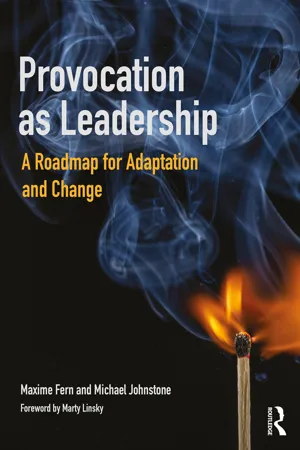
Provocation as Leadership
A Roadmap for Adaptation and Change
- 250 pages
- English
- ePUB (mobile friendly)
- Available on iOS & Android
About This Book
To create deep change, you have to disturb people, or at least risk doing so. Shaking people out of their comfort zones not only generates the possibility of change but also elicits new information and brings out hidden resources that people need to navigate unfamiliar waters. Nevertheless, provoking without antagonizing or shutting people down and tolerating their pushback are complex challenges, requiring skill and will.
This is the first comprehensive provocation roadmap: why provocation is necessary for effectively leading change, the different forms of provocation, action tools and frameworks, and case studies illustrating how change is achieved through the sustained and careful use of provocation and disturbance, with strategies and tactics for minimizing the risks involved. We illustrate, for example, how two Australian farmers challenged centuries-old farming practice to regenerate their properties and how a large American bank used the death of a revered CEO to reinvigorate the business. We show how a young indigenous school principal tackled entrenched attitudes to turn a failing school around and how a national statistical service acted like a technology start-up to innovate during the Covid-19 pandemic. The case studies address change at the local level, within organizations, as well as on a national scale. We finish with a synthesis of the lessons learned and a set of ideas about building people's capacity to use provocation to live, learn, and thrive.
Provocation as Leadership offers a blueprint for people who, using provocation, want to ignite change and help their organizations, group, or community break through to a better future. This book provides a vehicle to see provocation in its potential for necessary disturbance, to lay bare its anatomy, and give access to its possibilities, including how to enable provocateurs to live another day.
Frequently asked questions
Table of contents
- Cover
- Endorsements
- Half Title
- Title Page
- Copyright Page
- Dedication
- Contents
- About the authors
- Foreword
- Acknowledgements
- Introduction
- Part 1: What is provocation and why is it necessary?
- Part 2: Provocative capabilities and skills
- Part 3: Types of provocation
- Part 4: Application—Practicing provocation
- Part 5: Risks and lessons of provocation
- What to do next?
- Bibliography
- Index